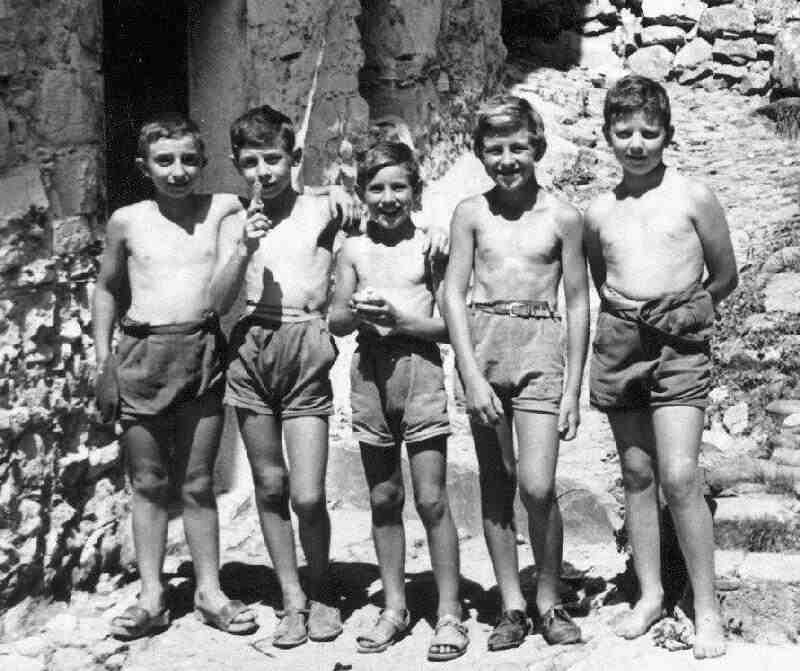
Italian Footwear: Types

Figure 1.--This photo was taken in summer 1954 in Soldano, a very little village in the hills near Genoa.
The boys on a waem day wear short pants and are bare-chested. About footwear we can see five different choices: clogs, close-toe and open-toe sandals, shoes and bare feet--all worn without socks.
|
|
We note Italian boys wearing a wide range of footwear. The shoes worn seem similar to styles in other European countries, although sandals seem especially common in Italy. Particularly in southern Italy. We note boys wearing high-top shoes in the 219th and early-20th century. Thery were not as common in Italy as in northern Europe vecause so msany children went barefoot. Gradually low-cut oxfords became more common, Sandals appear to have been very popular in Italy, especially after World War I. We we have noted Italian boys wearing a variety of styles. Open-toe sandals seem common in Italy well beforte they were seen in northern Europe. Seasonal factors probably played a role in the popularity of sandals. Italy's relative poverty probanly was another factor. They were to some extent seasonal, but they were also seen as a style for children throughout the year. An Italian reader tells us about "ciocie" (singular "ciocia") which were typical footwear in the country near Rome. Sneakers began to become an important footwear type in the 1970s. We also notice children, both boys and girls, wearing flip-flops, especially during the summer. They seem to be coming more common in the 2000s.
Shoes
The shoes worn seem similar to styles in other European countries, although sandals seem especially common in Italy. Particularly in southern Italy. We note boys wearing high-top shoes in the 219th and early-20th century. Thery were not as common in Italy as in northern Europe vecause so msany children went barefoot. Gradually low-cut oxfords became more common. Sneakers appeared in the 1960s, but did not become a major footwear type until the 1970s.
Sandals appear to have been very popular in Italy, especially after World War I. We we have noted Italian boys wearing a variety of styles. Open-toe sandals seem common in Italy well beforte they were seen in northern Europe. We also note closed-toe sandals. To some extent social-class was a factor. Children from affluent families were more likely to wear closed-toe sandals. Here there were also regionsal factors. We see closed-toe sandals mnore commonly in northern thsan southermn Europe. Seasonal factors probably played a role in the popularity of sandals. Italy's relative poverty probably was another factor. They were to some extent seasonal, but they were also seen as a style for children throughout the year. While sneakers in the 1970s provided a popular alternative, snadals still continue to be worn, especially in the summer. The Italian term for sandals is "sandali". Italian movies during the 1940's to the 60's seem to show any child not yet a teenager wearing sandals. Even some older boys wore them. During the summer boys often wore sandals without socks. Sandals now seem to be much less commonly worn in Italy. An Italian reader confirms that indeed sandals have been commonly worn in Italy and still are in the 2000s, although not as much as in the past. An Italian reader tells us about "ciocie" (singular "ciocia") which were typical footwear in the country near Rome. We are not sure if they should be considered am of sandal.
We notice children, both boys and girls, wearing flip-flops, especially during the summer. We are not sure when flip-flops first appeared in Italy, probably during the 1970s. They were at first mostly for beachwear or play around the house. Girls wore them more than boys. They have gradually become more popular. An Italian reader tells us that in 2006 and 2005 more boys seem to be wearing flip-flops. Sometimes we even see little boys wearing flip flops also in some formal occasion, e.g. during Sunday mass.
HBC

Navigate the Boys' Historical Clothing Italian pages:
[Return to the Main Itlalian page]
[Italian art]
[Italian catalogs]
[Italian choirs]
[Italian movies]
[Italian royalty]
[Italian school uniforms]
[Italian youth groups]
Navigate the Boys' Historical Clothing Web Site:
[Return to the Main Italian footwear page]
[Introduction]
[Activities]
[Biographies]
[Chronology]
[Cloth and textiles]
[Clothing styles]
[Countries]
[Topics]
[Bibliographies]
[Contributions]
[FAQs]
[Glossaries]
[Images]
[Links]
[Registration]
[Tools]
Created: 3:42 AM 4/5/2009
Last updated: 3:42 AM 4/5/2009



